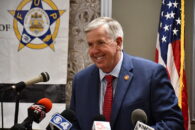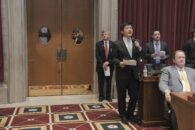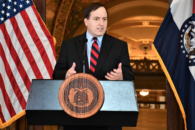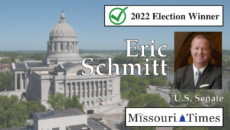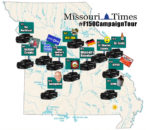Social media has been an important part of campaigning for almost a decade now, but campaigns are learning they must constantly adapt. While some utilize new platforms like Snapchat, others dive deeper into more traditional tools like Facebook and Twitter.
Ultimately, campaigns must use what works best for the candidate and most likely a multi-platform approach to social media benefits most.
The best communications teams keep up to date on social media trends, said campaign communications consultant Rich Chrismer.
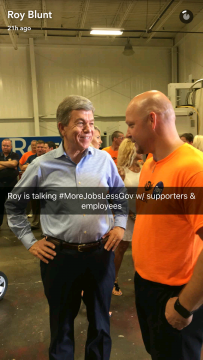 “If you’re running a social media campaign in 2016 based on a 2014 model, your plan is already outdated,” he said.
“If you’re running a social media campaign in 2016 based on a 2014 model, your plan is already outdated,” he said.
In Missouri, candidates like U.S. Sen. Roy Blunt, Secretary of State Jason Kander and Sen. Eric Schmitt have taken to Snapchat as a means of spreading their message. Because of its use among younger demographics, Snapchat Stories have appeal for campaigns.
“It can be an effective way to document a candidate’s travel,” Chrismer said. “Others have used the platform to announce their campaigns or to feature a quick comment from special supporters and guests.”
 Over the last month, Blunt has been particularly active on the platform as his campaign documented his travels across the state on his “More Jobs, Less Government” bus tour.
Over the last month, Blunt has been particularly active on the platform as his campaign documented his travels across the state on his “More Jobs, Less Government” bus tour.
His team published pictures and videos on the platform, often using geotags to signify the campaigns location.
He used Snapchat for more than just videos of the talks he gave, though he certainly did a lot of that. The campaign also documented where they ate and the locations where Blunt gave speeches.
While using traditional tools like Facebook and Twitter, Blunt has also used Facebook Live during these events.
On the other end of the spectrum resides the Jay Ashcroft campaign for secretary of state. He’s found success aggressively using Facebook to engage with followers.
The strategy includes creating a Facebook event for every campaign event. It allows the campaign to keep track of who’s attending and it lets attendees followers see who they support.
“We ask our stronger supporters to reach out to their friends and invite them to the events. It sort of goes back to traditional political thought that all politics is local and the best kind of communication is through someone’s trusted friend,” said Joe Lakin, director of digital strategies for Victory Strategies, which consults on the campaign. “There’s no better endorsement than someone’s friend or family member. We’ve worked really hard to utilize social media and events to give de facto endorsements from our supporters to their friends and family and online connections.”
Chrismer agreed that events can be valuable for a campaign.
“The Facebook event option is a great way for campaigns to invite groups to rallies and other campaign events, as well as their GOTV efforts in the general election and the primary,” he said.
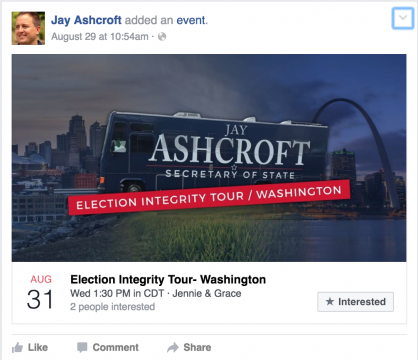
The campaign has also taken advantage of Facebook’s preference for graphics and videos. It posts photos from Ashcroft events and a new graphic goes on the cover of the event featuring a bus and the town hosting the event.
It all helps keep up with Facebook’s fabled algorithm, which dictates what shows up where in users’ newsfeeds.
“The Ashcroft campaign has really used every tool at its disposal in terms of social media, not only trying to reach broad audiences through advertising, but also using targeted techniques to engage its followers online and also to organize supporters for events and other campaign activities,” Lakin said about the campaign’s Facebook strategy.
Whether it’s Blunt’s Snapchat usage or Ashcroft’s Facebook page, both campaigns follow some key points that Chrismer has for using social media. One of the most important, Chrismer said, is that candidates need to have personal buy in.
“Voters, I believe, can often tell when a post is directly from a candidate or from the campaign,” he said. “No one, I believe, is expecting a candidate to draft every post. But it’s important for candidates to communicate with voters directly and authentically. Social media is a great way for them to do that. I advise candidates to be invested in their social media programs. Because it is such a great opportunity to communicate what they believe in, about their families, and most importantly, their policies for Missouri.”
But even with an increased focus on social media, there are potential pitfalls. Chrismer recommends to clients that if they want to weigh in on a controversial issue, they should draft their post in a separate document and walk away for a couple minutes before deciding whether to hit send.
He also warned that campaigns shouldn’t overfocus on social media over other campaign basics like phone banking and hitting doors.
“There is a risk of spending too much time on social media instead of some other important fundamentals like phone stores and events,” he said.
“A high five in the campaign office over a clever tweet could be a missed opportunity for a phone call or a one-on-one conversation with a voter.”



